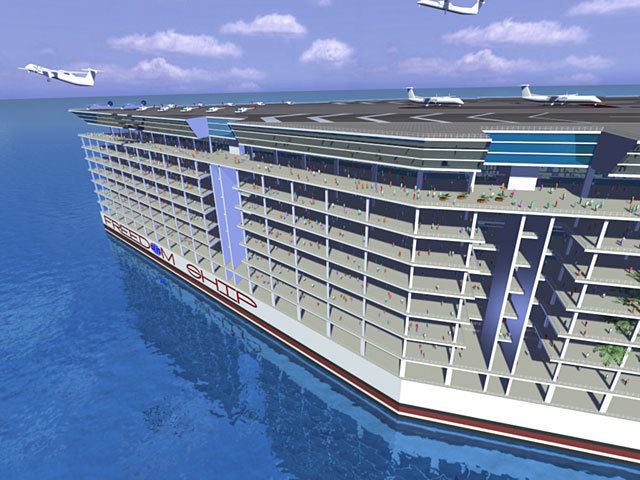Roof 106.7 m (350 ft) Floor count 25 | Height 107 m | |
 | ||
Type Mixed use (casino, education, hotel, office and residential) Size 1,371 m (4,498 ft) long, 225 m (738 ft) wide Architect Freedom Ship International Number of rooms 33,000 units (18,000 living units, 3,000 commercial units, 2,400 time-share units and 10,000 hotel units) Similar RMS Queen M, Labadee, Sky City | ||
Freedom Ship is a floating city project initially proposed in the late 1990s. It was so named because of the "free" international lifestyle facilitated by a mobile ocean colony, though the project would not be a conventional ship, but rather a series of linked barges.
Contents
Map of Freedom Ship, Palm Harbor, FL 34683, USA
The Freedom Ship project envisions a 1317 m (0.818 mi)-long integrated city with condominium housing for 50,000 people, an airstrip to accommodate turboprop aircraft, duty-free shopping and other facilities, large enough to require rapid transit. The complex would circumnavigate the globe continuously, stopping regularly at ports of call.
Construction
Despite early press coverage on NPR's Weekend Edition and Discovery Channel's Extreme Engineering, the project has seen few recent developments. Although the initially stated in-service date was to be 2001, no construction had begun as of November 2016.
Freedom Ship International initially estimated the net cost for construction to be USD 6 billion in 1999. However, by 2002, estimates had risen to USD 11 billion. A July 2008 press release explained the difficulty of obtaining reliable financial backing. In November 2013, the company announced that the project, now with an estimated price of USD$10 billion, was being resurrected, though that construction had not yet begun.
Similar projects
The basic idea was already published by Jules Verne in his novel Propeller Island, even so no technical details were given. It includes the idea of building a gigantic raft. The main aim of the project was saving taxes and the Island was moving around the earth on a yearly basis.
Other projects, such as the ResidenSea, have similarly attempted to create mobile communities, though they have conservatively limited themselves to the constraints of conventional shipbuilding. In regards to the economic flexibility and "freedom" created by such mobile settlements, these projects could be considered a realization of the avant-garde Walking City concept from 1964, by British architect Ron Herron of the group Archigram. The Freedom Ship also served as the inspiration for (and is closely resembled by) the Libertania, a mobile ship depicted in Grant Morrison's comic book The Filth. Buckminster Fuller also proposed, in the 1950s, "floating cities" approximately a mile wide that could accommodate up to 50,000 permanent inhabitants. Mike Wallace interviewed Buckminster Fuller on TV regarding this "floating cities" concept which Fuller explained would free up land needed for agriculture and industrial uses.
